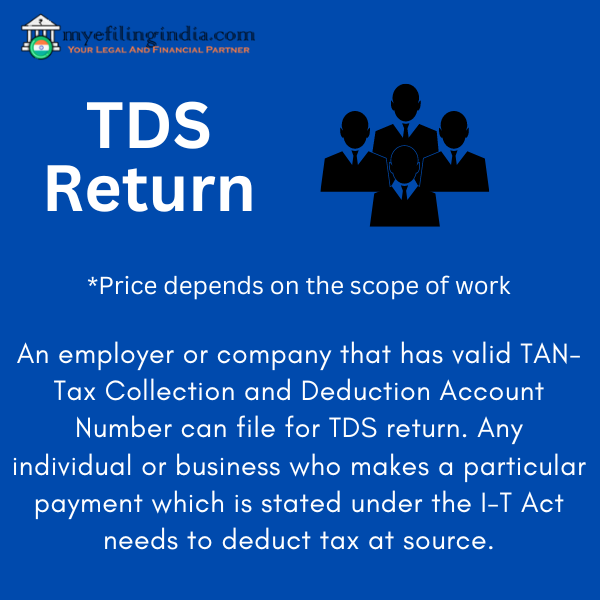TDS Return
₹749.00
-
Documents Required for Online TDS Return Filing
To file TDS returns electronically, you will need to have the following documents ready:
- Deductor/Collector Details: PAN, TAN, and address details of the deductor/collector.
- Taxpayer Details: PAN, name, and address details of the taxpayer.
- Challan Details: Challan number, the amount paid, and date of payment for the deducted/collected tax.
- Tax Deducted/Collected Amounts: Accurate breakdown of the tax deducted/collected for each taxpayer.
- Accounting Software or Tax Preparation Software: If applicable, you may need to have access to accounting software or tax preparation software to generate the necessary return files.
Description
Overview of TDS and TCS
Tax Deducted at Source (TDS) and Tax Collected at Source (TCS) are two tax collection methods in India. The deductor collects TDS from the payee at the time of payment for certain specified payments. The collector collects TCS from the seller of certain specified goods or services at the time of sale.
Who must submit e-TDS/TCS statements?
All persons responsible for deducting or collecting tax at source must submit e-TDS/TCS statements. This includes:
- Employers who deduct tax on salary payments
- Banks who deduct tax on interest payments
- Individuals who deduct tax on rent payments
- Companies that collect tax on payments made to contractors
Will I have to pay an upload fee to correct e-TDS/TCS returns?
No, there is no upload fee for correcting e-TDS/TCS returns. However, there may be late fees if the corrections are not filed within the due date.
Filing Your TDS and TCS Returns Online
The Indian Income Tax Department mandates individuals responsible for deducting or collecting tax at source (TDS/TCS) to electronically file their returns using the Tax Information Network (TIN) website
TDS and TCS Return Types for Individuals and Businesses
There are 2 types of TDS/TCS returns:
- Quarterly returns: Filed every three months, covering the periods April-June, July-September, October-December, and January-March.
- Annual returns: Submitted once a year, covering the entire financial year.
TDS and TCS Return Forms
The following are the TDS/TCS return forms:
- Form 24Q: This form is used for filing quarterly TDS/TCS returns.
- Form 26Q is used for filing annual TDS/TCS returns.
- Form 27A is used for submitting control charts and TDS/TCS returns.
Payment Due Dates and Penalties
The due dates for payment of TDS/TCS are as follows:
- Quarterly payments: The due date for paying TDS/TCS for each quarter is the 7 of the coming month.
- Annual payments: The due date for TDS/TCS for the financial year is the 31 of March of the next year
The Late payment of TDS/TCS gets a penalty of 1% of the outstanding amount per month.
TDS and TCS Payment Deadlines
The deadlines for payment of TDS/TCS are as follows:
- Quarterly payments: The deadline for TDS/TCS for each quarter is the 30 of the coming month
- Annual payments: The deadline for TDS/TCS for the financial year is the 31 of May of the next year
Unable to pay TDS/TCS on the deadline results in a penalty of 2% of the outstanding amount every month.
Here are the steps on how to file TDS/TCS returns online:
- Talk to our expert
- Check the status of the e-TDS/e-TCS
- Select the type of return you want to file (quarterly or annual)
- Submit the required details and upload the return file
- We will submit the return on your behalf and throw away the complexities.
Once the return has been submitted, you can generate a challan to pay TDS/TCS. The challan can be paid online or through a bank.
Consequences of Missing Payment Deadlines
Failing to meet TDS/TCS payment deadlines can result in significant penalties and legal repercussions. These consequences may include:
- Penalty for Late payment: A penalty of 1% is levied on outstanding TDS/TCS amount for every delay
- Interest charges: Interest is charged on the outstanding TDS/TCS amount at 12% per annum from the due date of payment until the date of actual payment.
- Prosecution: In severe cases of non-compliance, legal action may be initiated against the deductor or collector of TDS/TCS. This could involve prosecution under the Income Tax Act, leading to fines or imprisonment.
Simplifying TDS and TCS Return Filing and Compliance
The process of TDS/TCS return filing and compliance can be simplified by following these measures:
- Maintain Current Knowledge of TDS/TCS Regulations: Keep abreast of TDS/TCS rules and regulations to ensure accurate tax deduction, collection, and payment.
- Utilize e-filing platforms: Leverage the Income Tax Department’s e-filing platforms to streamline the process of filing TDS/TCS returns electronically, eliminating the hassle of manual submissions.
- Adopt accounting software: Employ accounting software or utilize the services of tax professionals to automate TDS/TCS calculations, ensuring timely and accurate deductions.
- Maintain proper records: Detailed records of TDS/TCS deductions, collections, and payments to facilitate easy reconciliation and compliance audits.
Important Considerations Before Filing TDS and TCS Returns
Before filing TDS/TCS returns, it is crucial to consider the following aspects:
- Determine the type of return: Identify whether you need to file a quarterly (Form 24Q) or annual (Form 26Q) return based on the applicable tax deduction period.
- Gather relevant information: Collect all necessary details related to TDS/TCS deductions, collections, and payments, including challan numbers, tax deducted amounts, and taxpayer details.
- Verify tax deduction rates: Ensure that the correct TDS/TCS rates are applied for each type of payment made during the relevant period.
- Validate taxpayer information: Cross-check taxpayer details, such as PAN numbers, to avoid discrepancies or errors in the return.
Step-by-Step TDS and TCS Return Filing Process
The step-by-step process for filing TDS/TCS returns electronically is as follows:
- Access the e-filing portal: Visit the TIN website and log in using your credentials.
- Select e-TDS/e-TCS option: Click on the “e-TDS/e-TCS” tab to access the return filing section.
- Choose the return type: Select the type of return you want to file, either quarterly (Form 24Q) or annual (Form 26Q).
- Enter details and upload the return file: Provide the required information, including deductor/collector details, tax deducted/collected amounts, and taxpayer details. Upload the generated return file.
- Generate challan: Once the return is submitted, generate a challan to pay TDS/TCS.
- Make TDS/TCS payment: Pay the TDS/TCS amount through the generated challan online or through a bank.
- File correction statements (if applicable): If errors or omissions are discovered, file correction statements using Form 27A.
Our Vakilsearch experts can file it on your behalf, and you can avoid complexities!
Understanding the Timeline for TDS and TCS Refunds
The timeline for TDS and TCS refunds depends on various factors, including the accuracy of the return filed, the timeliness of e-verification, and the complexity of the refund assessment. However, TDS and TCS refunds are generally processed within 3 to 6 months of filing the return.
Here’s a breakdown of the refund process:
- Return Filing: File your TDS/TCS return accurately and on time.
- E-verification: Complete the e-verification process promptly to expedite the refund process.
- Refund Assessment: The Income Tax Department assesses the refund claim once the return is processed.
- Refund Processing: Upon approval, the refund is processed and credited to your account within a few weeks.
Common Errors in TDS and TCS Filing and How to Correct Them
To avoid delays in refunds and potential penalties, it is crucial to file accurate and error-free TDS/TCS returns. Here are some common errors to watch out for and how to rectify them:
- Incorrect Deductor/Collector Details: Ensure the deductor/collector details, such as PAN and TAN, are accurate and match the records maintained by the Income Tax Department.
- Mismatched Taxpayer Information: Verify taxpayer details, such as PAN and name, to avoid discrepancies that could delay refunds.
- Inaccurate Tax Deducted/Collected Amounts: Double-check TDS/TCS calculations and ensure the correct tax rates have been applied.
- Errors in Challan Details: Cross-check challan details, including the challan number and amount paid, to avoid discrepancies in tax payment records.
- Filing Returns Beyond the Due Date: Late filing of returns can attract penalties and delay refunds.
To correct any errors, file correction statements using Form 27A within the specified timeframe.
Benefits of Timely TDS and TCS Return Filing
- Avoids Penalties: Timely filing helps avoid late filing penalties and interest charges.
- Ensures Timely Refunds: Prompt filing ensures timely processing of refund claims.
- Promotes Compliance: Timely filing demonstrates adherence to tax regulations and strengthens the taxpayer’s reputation.
- Reduces Audit Scrutiny: Timely filing reduces the likelihood of tax audits and scrutiny.
Importance of TDS and TCS Certificates
TDS and TCS certificates are crucial documents for both the deductor/collector and the taxpayer, playing a significant role in tax compliance and reconciliation.
Importance for Deductors/Collectors
- Evidence of Tax Compliance: TDS/TCS certificates serve as tangible proof that the deductor/collector has fulfilled their obligation to deduct or collect tax at source. This documentation is essential for audits and tax assessments.
- Accurate Tax Payment Records: These certificates maintain a clear record of tax deductions or collections made, ensuring accurate accounting and reconciliation of tax payments.
- Protection from Penalties: Timely issuance of TDS/TCS certificates helps avoid penalties for non-compliance or delayed tax payments.
- Facilitates Tax Deposits: TDS/TCS certificates provide the deductor/collector with the necessary information to deposit the deducted/collected tax with the government.
Importance for Taxpayers
- Pre-filling of Income Tax Returns: TDS/TCS certificates provide pre-filled details of tax deductions or collections, simplifying the process of filing income tax returns.
- Tax Payment Reconciliation: These certificates help taxpayers reconcile their tax payments and ensure that the deducted/collected tax is properly credited to their accounts.
- Proof of Tax Deduction: TDS/TCS certificates serve as proof of tax deduction at source, allowing taxpayers to claim tax credits or refunds if applicable.
- Accurate Tax Liability Assessment: These certificates provide accurate information about tax deductions, enabling taxpayers to assess their tax liability correctly.
Filing a Revised TDS or TCS Return for Correcting Errors
Filing a revised TDS or TCS return is necessary to rectify any errors or omissions made in an original return. This process helps ensure the accuracy of tax deductions and collections, avoiding potential penalties and ensuring timely refunds.
Steps to File a Revised TDS or TCS Return:
- Identify Errors: Carefully review the original return to identify any errors or discrepancies in challan details, taxpayer information, tax deducted/collected amounts, or other relevant data.
- Access e-Filing Portal: Log in to the TIN website (https://tin.tin.nsdl.com/index.html: https://tin.tin.nsdl.com/index.html) using your credentials.
- Navigate to the e-TDS/e-TCS Section: Select the “e-TDS/e-TCS” tab to access the return filing section.
- Choose Return Type: Choose the type of return you want to revise, either quarterly (Form 24Q) or annual (Form 26Q).
- Select Revised Return Option: Click on the “Revised Return” option to initiate the revision process.
- Provide Original Return Details: Enter the original return’s acknowledgement number and challan number to link the revised return to the original one.
- Enter Revised Information: Make the necessary corrections to the challan details, taxpayer information, tax deducted/collected amounts, or any other relevant data.
- Generate Revised Challan: Once the revised information is updated, generate a revised challan for the payment of any additional tax or refund due.
- Make Payment or Claim Refund: Pay the additional tax or claim the refund as per the revised challan details.
- File Revised Return: Submit the revised return electronically.







Your review is awaiting approval
j1nol9